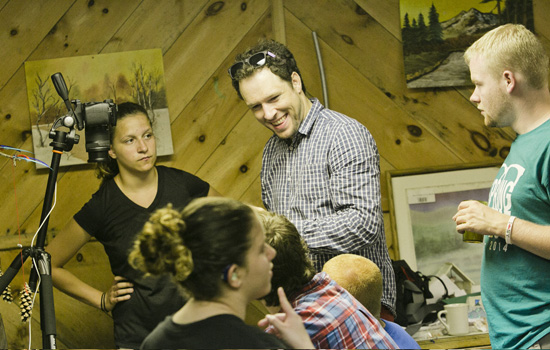‘Happy’ video with RIT/NTID ties goes viral
Who says there’s no happy news? Clip appears on ‘ABC World News Tonight’
Tate Tullier
Deaf Film Camp instructor Braam Jordaan of South Africa, with students Annna Rose Woods-Jacobowitz of the Maryland School for the Deaf and Rogan Shannon of RIT/NTID at Camp Mark Seven, while making their ‘Happy’ video.
A music video from an Adirondack summer camp for aspiring deaf teen filmmakers and co-sponsored by Rochester Institute of Technology’s National Technical Institute for the Deaf has gone viral.
That video, an adaptation of the Pharrell Williams song “Happy,” was done in American Sign Language. It received more than 797,000 hits on YouTube and was People.com’s video of the day. It has garnered the attention of The Huffington Post, Entertainment Tonight Online and ABC World News Tonight, when host Diane Sawyer showed a brief clip of the video and used her hands to say, “You make us feel … ” and then signed “happy.” The next day, the network repeated the clip and said Williams had tweeted, “Thank you Camp Mark Seven for this ASL version of HAPPY.”
The Deaf Film Camp, located at Camp Mark Seven in Old Forge, N.Y., has strong ties to RIT/NTID. Three RIT/NTID alumni made the video possible: the film camp’s founder, Stacy Lawrence of Pittsford, N.Y.; a main performer in the video, Rosa Lee Timm of Riverside, Calif.; and noted filmmaker Wayne Betts of New York City, who helped film the video.
In addition, five former or current NTID students worked as counselors at the camp and are featured in the video: Danica Metlay and Kara Matchett of Rochester; Rogan Shannon of Mt. Vernon, Wash.; Matthew Pituk of Mobile, Ala.; and Josh Bishop of Carlisle, Pa.
“I was absolutely blown away,” Lawrence said about seeing the completed video. “I loved every single second of the music video. I watched as the video progressed how each person’s energy had changed as they worked together. They all came from diverse backgrounds, yet they all came together and worked beautifully together.”
Twenty-four campers, ages 13 through 16 from across the country, attended the camp, which concluded Aug. 1.
Lawrence, who hopes to expand the number of campers who can attend next year, has seen comments about the video from around the world. She said deaf campers from England, France, New Zealand and India have already expressed interest in traveling to the Adirondacks next summer to attend the camp.
“I want the world to know that deaf kids are happy people because they use such a beautiful language to express themselves,” Lawrence said. “And at Camp Mark Seven, kids can feel safe to be themselves, with no communication barriers. You see the positive attitude start to take effect immediately.”
The campers worked in groups of six to learn technical aspects of filmmaking, including animation, screenwriting, directing, acting, special effects, lighting and camera angles. Two other videos the campers made about their experience at the camp are expected to be released soon, Lawrence said.
Last year’s video from the camp, a rendition of One Republic’s “Feel Again” in American Sign Language, generated more than 28,000 views on YouTube.
NTID President Gerry Buckley, who visited the camp where he serves as a member of its foundation board, said two of the campers told him they planned to apply to RIT’s film and animation program because of the experience they had there.
RIT is the most accessible campus for deaf and hard-of-hearing college students in the country, with more than 130 sign language interpreters and more than 50 classroom captionists. More than 1,200 deaf and hard-of-hearing students from across the country and beyond typically attend RIT/NTID, making it the most popular undergraduate program for deaf and hard-of-hearing students in the country.















